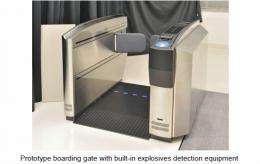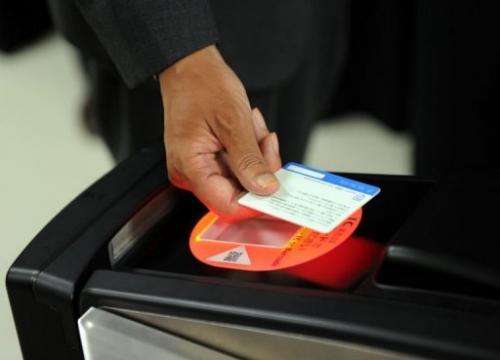Prototype boarding gate with built-in explosives detection

Hitachi, in collaboration with The Nippon Signal and the University of Yamanashi, have successfully prototyped a boarding gate with built-in explosives detection equipment as part of efforts to increase safety in public facilities such as airports. The prototype boarding gate efficiently collects minute particles which have affixed themselves to IC cards or portable devices used as boarding passes, and can detect within 1-2 seconds the presence of explosive compounds using internalized equipment. With this method, it is possible to inspect 1,200 passengers per hour. The technology is expected to contribute to the prevention and containment of carry-on explosives as it inspects immediately prior to boarding without disrupting the flow of passengers, and provides increased security without affecting convenience.
In recent years, to ensure safety and security in transport services, there has been a need increase security to discourage and prevent the carrying-on of explosives into to transports such as airplanes. For example, flight safety would be significantly increased if it were possible to inspect passengers for explosives at the boarding gate, the last point of inspection before boarding the flight; however, as several hundreds of passengers need to pass through the gate at once, the time taken by conventional metal detectors and X-ray inspections was an issue.
The prototype boarding gate employs mass spectrometry technology which can detect the presence or absence of explosive compounds within 1-2 seconds. As a result, it is now possible to simultaneously check the boarding passes contained in IC cards or portable devices while inspecting all passengers for explosive compounds without affecting the flow of passengers passing through the gate.
As this equipment can be adapted to entrance security equipment for train stations, stadiums, event halls, etc. in the future, it is expected to contribute as platform technology to achieving the safety and security of public spaces.

Features of the prototype boarding gate with built-in explosives detection equipment are as described below.
(1) High-speed collection of minute particles adhering to IC cards or portable devices while reading the device.
Technology utilizing high speed air current to collect minute particles attached to IC cards or portable devices used as boarding passes, while reading the card or device, was developed. The efficient extraction and collection of the minute particles within a short period of time was achieved by optimizing the timing to generate the air flow, positioning of the pass, and air current speed.
(2) High-speed concentration of the collected particles and high-sensitivity mass spectrometry analysis
In order to achieve high-sensitivity mass spectrometry, it was necessary to release the unnecessary gas to outside the equipment and increase the concentration of the particles since the particles are collected within a large volume of air, cyclone method centrifugal technology was employed to efficiently and quickly separate and collect only the particles from the gas, enabling the particles to be introduced into the mass spectrometer to be collected and concentrated in a short time, thus achieving high sensitivity mass spectrometry.
(3) Internalized compact high-sensitivity mass spectrometer
A linear ion trap type high sensitivity mass spectrometer which can continuously detect explosive compounds in real-time was employed, and by innovating the assembly of the power and control systems, the size of the equipment was reduced even further to achieve internalization within a boarding gate.
The prototype equipment developed will be on display at the Special Equipment Exhibition & Conference for Anti-Terrorism (SEECAT' 12) which will be held from 17th – 19th October 2012 at the Tokyo Big Sight in Tokyo, Japan while conducting a continuous operation pilot test. Further pilot tests at public transport facilities are also planned in the next financial year.
Source: Hitachi


















